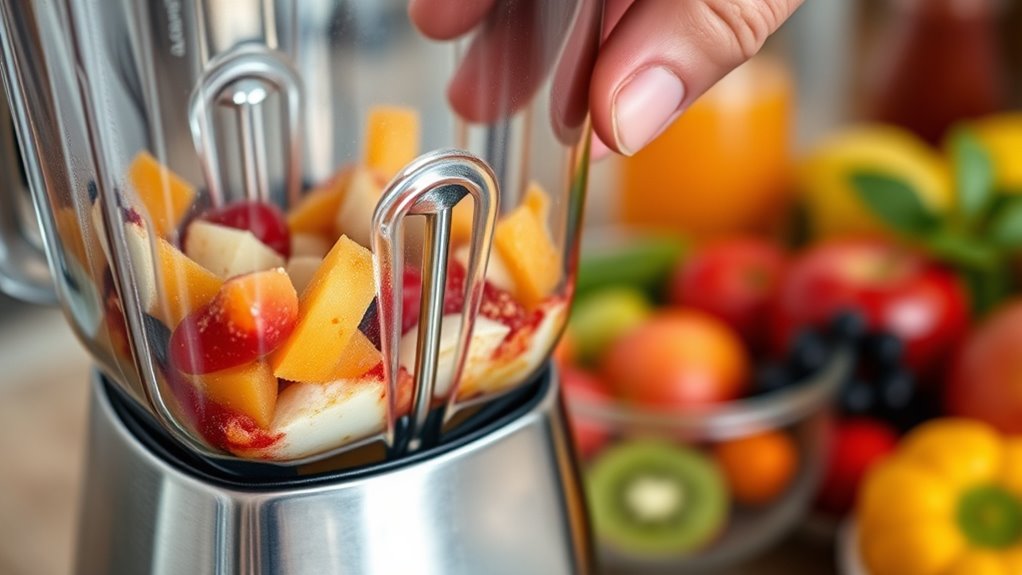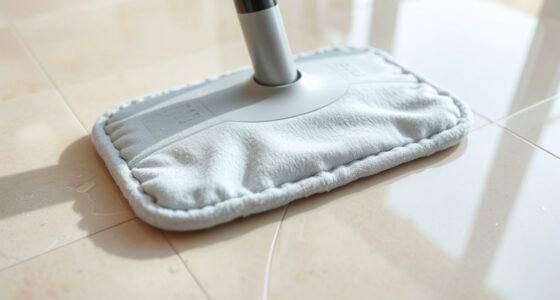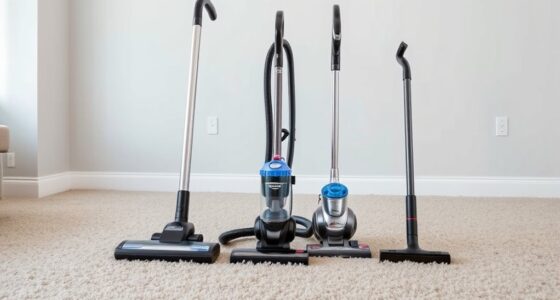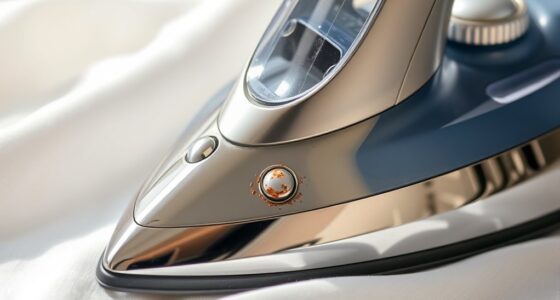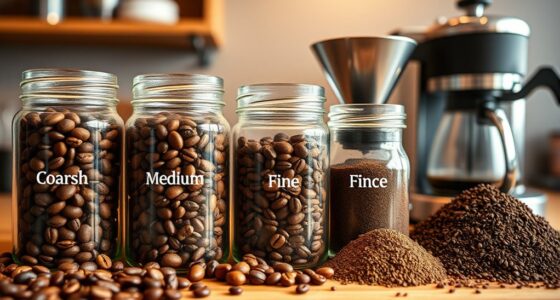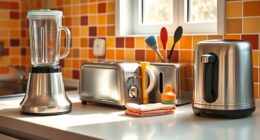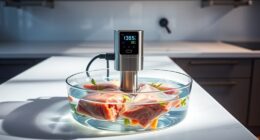If your blender isn’t blending smoothly, start by inspecting the blades for dullness or damage and replace them if needed. Make sure the jar is securely placed and compatible with your model to prevent leaks and vibration. Layer ingredients properly, placing liquids first and harder items on top, to reduce motor strain. Maintaining the blades and gasket regularly guarantees consistent performance. Continue exploring these tips to get your blender working like new.
Key Takeaways
- Check and sharpen or replace dull or damaged blades for better blending efficiency.
- Ensure the jar is properly seated and compatible with your blender model to prevent leaks and vibration.
- Load ingredients with liquids at the bottom and harder items on top to promote even blending.
- Regularly inspect and replace worn gaskets to prevent leaks and maintain optimal performance.
- Avoid overfilling the jar and use appropriate speed settings based on ingredient toughness.
Checking and Replacing Blender Blades

If your blender isn’t blending smoothly, the blades might be dull or damaged. First, check the blades for signs of dullness or chips. If they’re dull, consider blade sharpening to restore their cutting power. Damaged blades won’t blend properly, so replacing them could be necessary. Before replacing, inspect the jar gasket as well; a worn gasket can cause leaks and reduce blending efficiency. Replacing the gasket ensures a tight seal, preventing air pockets that hinder blending. When replacing blades, follow your blender’s instructions carefully to avoid injury. Also, ensure the blades are securely attached. Regularly maintaining and replacing dull blades and worn gaskets can considerably improve your blender’s performance, helping you achieve smooth, consistent blends every time. Proper maintenance can also prevent issues related to blender performance and extend the lifespan of your appliance.
Ensuring Proper Jar Placement and Compatibility
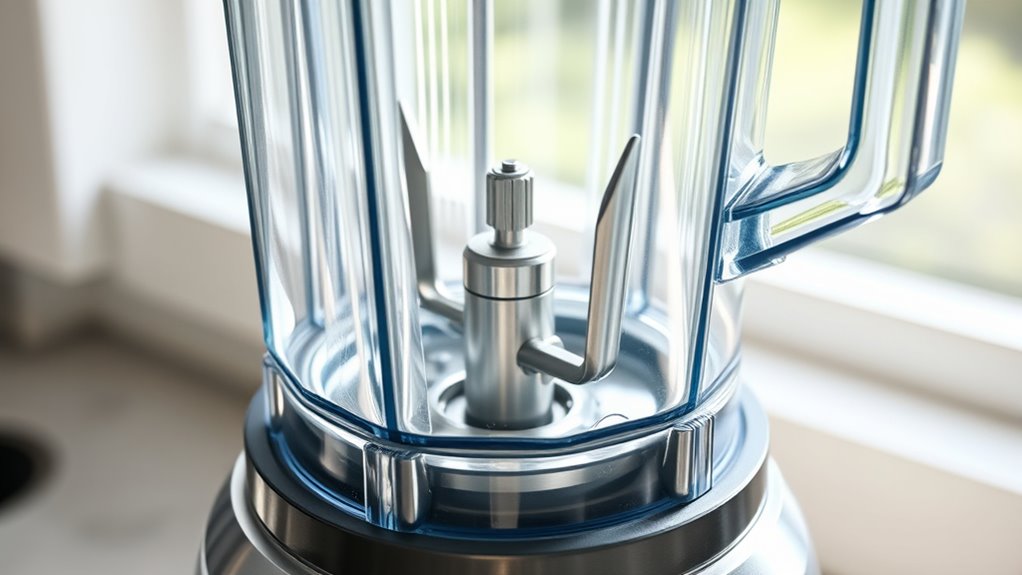
Proper jar placement is essential for ideal blending performance, as misaligned or improperly seated jars can cause leaks, uneven blending, or motor strain. Ensure the jar clicks securely into the base, and check that the lid is tightly sealed. Compatibility matters—using the right jar for your blender model prevents unnecessary strain on the motor and maintains optimum motor speed. When the jar is properly aligned, the blender runs quieter, reducing noise and vibration. If you notice increased noise or vibration, double-check the jar’s fit and compatibility. Proper placement ensures the blades engage correctly, improving blending consistency. Regular maintenance and understanding blender technology can also help prevent common issues and extend your appliance’s lifespan. Avoid forcing jars into place, as this can damage components or affect motor performance. Keeping jars correctly aligned and compatible helps your blender operate smoothly, quietly, and efficiently.
Optimizing Load Order and Ingredient Distribution
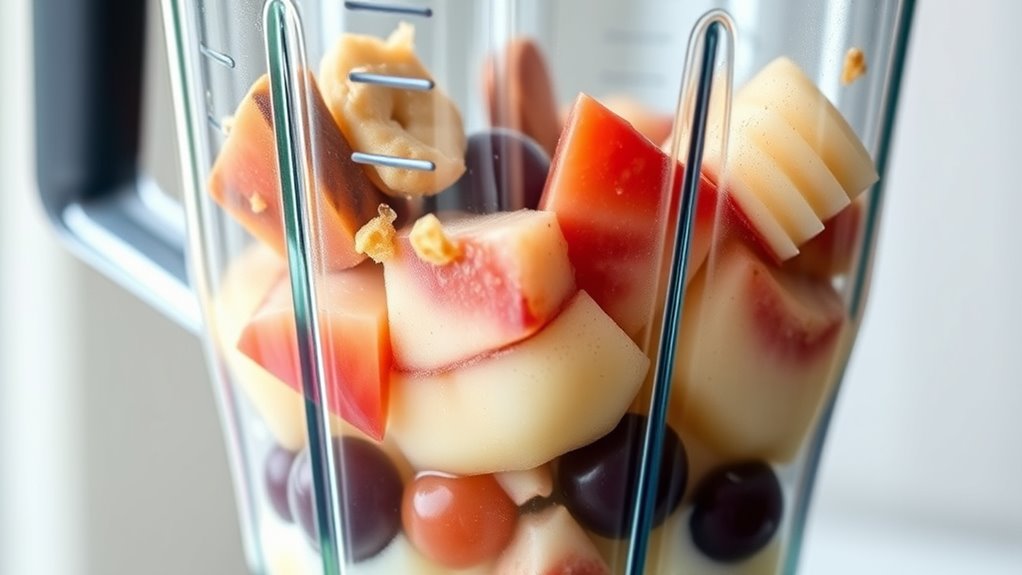
Arranging ingredients correctly inside the blender can make a significant difference in blending performance. To optimize load order, start with liquids or soft ingredients at the bottom, ensuring the blades are fully submerged. Harder items like ice or frozen fruits should go on top to prevent strain on the motor. Adjust your power settings accordingly; lower speeds work better for delicate ingredients, while higher settings handle tougher loads. Proper ingredient layering ensures even blending and reduces stress on the motor. Avoid overfilling the jar, which can hinder blending efficiency. By strategically loading ingredients and selecting appropriate power levels, you improve blending results and extend your blender’s lifespan. Additionally, understanding automation technologies can help you identify better tools and techniques for efficient blending. This simple adjustment transforms your blending experience, making smoothies smoother and more consistent.
Frequently Asked Questions
Can Overfilling the Blender Cause It to Not Blend Smoothly?
Yes, overfilling your blender can cause it not to blend smoothly. When you stuff it too full, the ingredients often become unevenly distributed, leading to inconsistent ingredient consistency and making it harder for the blades to process everything properly. This overload creates overfilling issues, putting strain on the motor and preventing a smooth blend. To fix this, avoid overfilling and leave enough space for ingredients to circulate freely.
Does the Type of Ingredients Affect Blending Performance?
Yes, ingredient consistency and blender material can affect blending performance. Thick or frozen ingredients may require a more powerful blender or longer blending time to achieve smoothness. Additionally, the blender jar’s material, like glass or plastic, impacts how well ingredients move and blend. Using ingredients with uniform consistency helps prevent clogs or uneven blending, ensuring you get a smooth mixture every time.
How Often Should I Clean or Replace My Blender Blades?
You should clean your blender blades after every few uses to prevent residue buildup, which can dull their effectiveness. As for blades maintenance and replacement frequency, consider replacing them every 1-2 years if you notice dullness or rust. Don’t ignore signs of wear, because worn blades struggle with blending, making your smoothies less smooth. Regular cleaning and timely replacement keep your blender performing at its best, ensuring perfect blends every time.
Are There Specific Jar Sizes Best for Smooth Blending?
Choosing the right jar size matters for smooth blending. A smaller jar, around 16 ounces, helps create a vortex, pulling ingredients down for a more consistent smoothie. Larger jars, like 32 ounces or more, can make blending tougher, causing uneven textures. For the best smoothie consistency, use a jar size that matches your ingredients and blender power, ensuring everything blends smoothly without overloading or underfilling.
Can Blending at Different Speeds Improve Smoothness?
Yes, blending at different speeds can improve smoothness. When you vary the speed, you create a ripple effect that helps break down ingredients more thoroughly, enhancing blending consistency. Starting slow and then increasing to high speed allows the blades to grip and process ingredients better. This technique prevents chunks and creates a silky, smooth texture, giving you control over the blending process and ensuring every blend is perfectly smooth.
Conclusion
By checking your blades, ensuring the jar fits correctly, and loading ingredients properly, you can make your blender blend as smoothly as a well-choreographed dance. Think of it like tuning a guitar—you’ll get the best sound when everything’s in harmony. So, take these simple steps, and soon you’ll enjoy perfectly smooth blends every time. With a little patience, your blender will work like a pro, turning even tough ingredients into silky perfection.
